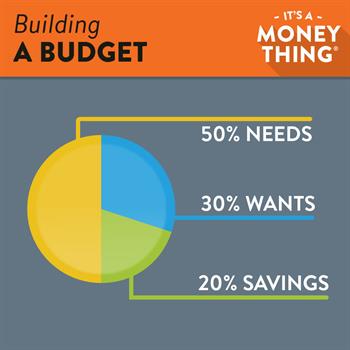It's a Money Thing®
Building a Budget
Budgeting is a skill that helps you make smart decisions with your money. It ensures that you're spending less than you earn, it prepares you for life's curveballs, and it funds your goals and your dreams. Unfortunately, budgeting is often seen as restrictive and overwhelming. Financial priorities are deeply personal, so it can be challenging to fund the right combination of strategies and tools that work for you.
If you're new to budgeting or if you don't feel confident with your current mix of budgeting tools, give proportional budgeting a try. A proportional budget divides your income into categories by percentage. It's a simple concept to apply, it pairs well with the spreadsheets and/or apps you may already be using, and it can be easily tailored to suit your specific needs. Most importantly, it will make you think about your expenses in an entirely new light.
The 50/30/20 budget recommends that you spend 50% of your income on needs, 30% on wants, and 20% on savings.
Step 1: Track your spending
To measure your budgeting progress, you need to know where you're at right now. Track your spending for at least two months. Capture your transactions however you like, but keep in mind that the more accurate you are, the more effective your 50/30/20 budget will be.
- Have your account and credit card statements handy to reference your purchase history easily
- Find a way to document cash transactions that aren't captured electronically
- Make sure your annual expenses are represented (examples include annual subscription renewals, annual service fees, and taxes)
Once you have a snapshot of your monthly spending, sort each of your expenses into one of three categories: Needs, Wants, and Savings.

Needs are your absolute essentials. Skipping these expenses can lead to extreme hardship, job loss, illness, or legal trouble. Therefore, your rent, your health insurance, your taxes, and your credit card minimum payments fall under the needs umbrella.
Wants are all your non-essential purchases. Some of these, like movie tickets, fast food, and subscription services, are easy to identify. Others ride the line between needs and wants. For example, your typical grocery bill can include food staples like eggs, flours, and veggies (needs) as well as snack foods and premium brands you prefer (wants). By using 50/30/20, you'll quickly realize that many of your needs are actually wants in disguise.
Savings are any expenses that go toward debt repayment or savings goals. Student loan payments, retirement savings, and emergency fund savings all fit into this category.

Step 2: Compare your percentages
Add up your spending totals in each category and calculate what percentage of your income they represent. If your totals for needs, wants, and savings already align to 50%, 30%, and 20% respectively, then congratulations - you must be magical! Realistically, your totals will be different, and that's OK because this will indicate where you need to make adjustments.
Every month, try to get closer to the 50/30/20 limits you determined in Step 1. If you find you're consistently overspending in a particular category, you have a few options available to you:
- Find cheaper options for regular expenses
- Sacrifice something from another category
- Increase your income
After a few months, the 50/30/20 budget will feel natural to you: you'll know which purchases are in line with your budget and which ones are not. You'll have a better understanding of - and therefore more control over - your spending.
Step 3: Keep at it
Some months are easier to budget than others. Don't get discouraged if an unexpected expense or a moment of weakness throws you off your budgeting game. Keep tracking your spending and chasing that balance of 50/30/20.
Proportional budgets like 50/30/20 help you determine what your priorities are and ensure that you're spending your money in a way that's aligned with those priorities. Whether you stick with it or ultimately transition to another system, 50/30/20 will shape your understanding of and confidence with budgeting.
